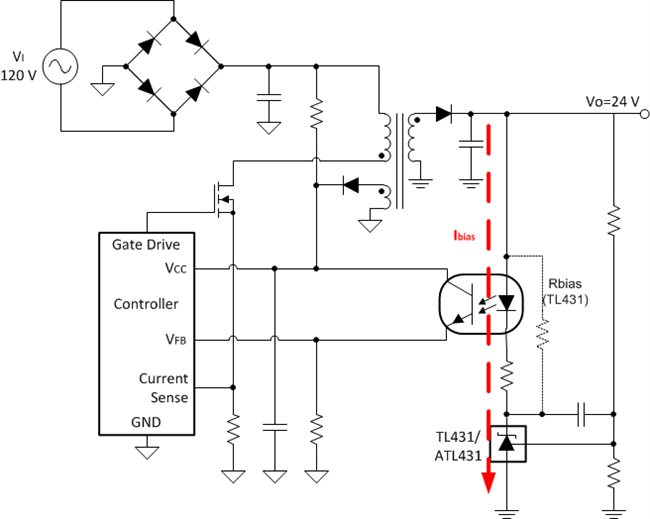SSZTCM8 june 2015 ATL431 , TL431
In the interest of reducing wasted power in consumer electronics, many government policy initiatives have been created to reduce no-load or standby power in AC to DC power supplies. Among these are the Environmental Protection Agency’s (EPA) ENERGY STAR and the European Union’s Standby Initiative. Last year, in an Analog Applications Journal article, TI’s Adnaan Lokhandwala discussed components commonly used in flyback supplies that dissipate a significant amount of standby power. In his article, Adnaan recommends using flyback converter ICs to reduce power by eliminating the optocoupler feedback circuit. However, this requires the power supply to be completely redesigned. Alternatively, by replacing the TL431 with the ATL431 standby power can be significantly reduced without significant redesign.
While the TL431 is a popular device that has been used for years in flyback supplies, its minimum required cathode current of 1 mA dissipates significant standby power. TI’s new ATL431 shunt regulator requires only 35 µA for its cathode current. With its lower cathode current, the ATL431 can be used to reduce the standby power dissipated by the feedback circuitry by a factor of 10 in designs that currently use the TL431.
Figure 1 shows the standard circuit of a flyback power supply. To ensure that the TL431 remains biased, a resistor, Rbias, is placed in parallel with the optocoupler. Just to bias the TL431, this circuit will dissipate 24 mW.
 Figure 1 General Schematic of a Flyback
Power Supply
Figure 1 General Schematic of a Flyback
Power SupplySince the ATL431 can operate well within the minimum current requirement for the optocoupler, the Rbias resistor is no longer needed. Using the ATL431, the no-load power consumption drops by a factor of 20. Table 1 illustrates the power savings of the ATL431 in flyback supplies.
| Required minimum shunt regulator cathode current (IKA(min)) | Required minimum current to bias the optocoupler | Power dissipated by components dissipating Ibias | |
|---|---|---|---|
| TL431 solution | 1 mA | 50 µA (R bias needed) | 24 mW |
| ATL431 solution | 35 µA | 50 µA | 1.2 mW |
The TL431 sets the required minimum bias current, Ibias, to 1 mA. This means that 1 mA will flow through the resistor, optocoupler, and shunt reference. In this case, the shunt reference sets the Ibias current.
When the design uses the ATL431, the minimum cathode current is so low that the optocoupler is the component that sets Ibias. In this case, Ibias is 50µA. When less current is used for Ibias, the no-load power consumption of the design decreases.
The lower cathode current requirement of the ATL431 shunt reference reduces no-load power consumption in any circuit that uses the TL431. By substituting the ATL431 for the TL431, no-load power consumption and wasted energy can be reduced in any existing power design.
Additional Resources:
- Download the ATL431 datasheet.
- Start your design in WEBENCH Power Designer
- Download the ATL431 Pspice transient models